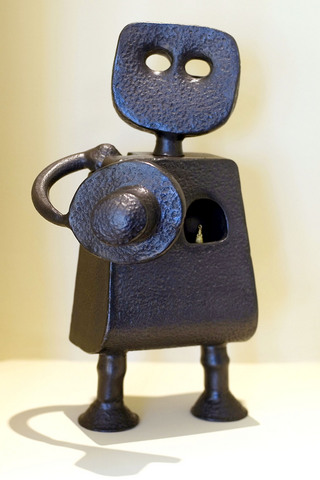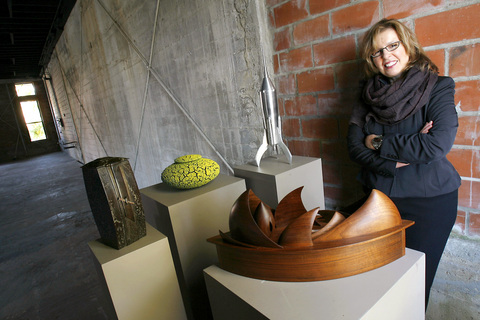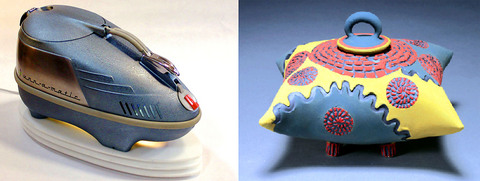It was nearly a year ago that Lauren Clauson's mother, Rose Karam, moved in with her daughter. Karam, a legal secretary who died at 78 after a protracted illness, resides beneath Clauson's living room window, in an artist-designed ceramic prayer wheel etched with stenciled leaves. Having her mother's remains close by — in an urn that celebrates Karam's affinity for autumn in New England, where she grew up — is comforting to Clauson, a 50-year-old transportation planner. "I'll walk by and give mom a spin," she said of the vessel, which is attached to a turntable. "Her presence is here."
The prayer wheel, designed by Christopher Moench, a 47-year-old artist from Bellingham, Washington, is part of an emerging funerary art movement that will reach an apotheosis of sorts when the nation's first art gallery dedicated to cremation urns and other "personal memorial art" opens Jan. 27 in Graton, California.
The gallery, christened Art Honors Life, will showcase the work of some 40 artists and craftspeople who are collectively pioneering a new aesthetic of death — creating sophisticated vessels of burnished terracotta, redwood burl, black glass, even biodegradable paper mixed with ashes from ancient oaks that, in terms of sheer artistic ambitiousness, hark back to the ancient Egyptians.

PHOTOS: NY TIMES NEWS SERVICE
"Art and beauty can assuage anxiety," said Maureen Lomasney, the 56-year-old artist and gallery owner who started the concept with a Web site called Funeria, and sponsored a juried exhibition in Philadelphia last fall called "Ashes to Art," a kind of Venice Biennale for the urn set. "Our goal is to take away fear."
Although artist-designed urns and other objects are still a tiny fraction of America's US$11 billion death-care industry, as it is known, the gallery's opening — along with novelty items like wind chimes with built-in cavities, pencils made from cremated remains (roughly 250 pencils per person), diamonds made from ash carbon and birdfeeders designed to scatter ashes — reflect the shifting demographics of death and disposition.
A decade ago, 21.1 percent of the Americans who died were cremated; in 2005, roughly 32 percent were. The numbers are steadily rising, with the Cremation Association of North America forecasting a cremation rate of 51.12 percent — more than half America's deaths — by 2025.

Located in a charming wine country hamlet, rather than in a cemetery, the new gallery taps into growing consumer demand for "personalization," especially among baby boomers nearing the finish line. Many of the objets, like Offerings, a US$1,100 participatory artwork by Tamar Kern of Newport, Rhode Island, are intended to help mourners with celebratory rituals. For Offerings, Kern reproduces casts of hands, with what she calls their "unique tracery," in fine silver, as a vessel for scattering or a family heirloom.
"The customization of the culture now includes life-cycle rituals like writing your own wedding vows," said Stephen Prothero, chairman of the religion department at Boston University and the author of Purified by Fire: A History of Cremation in America" (University of California Press, 2002). "Today, not having a cookie-cutter life also means not having a cookie-cutter death."
Lomasney, an artist and photographer, was inspired to start Funeria — a name she invented because it sounded Italian — after reading a 1997 newspaper article about rising cremation rates. She combed Internet sites like urnmall.com and urnexpress.com and was horrified by what she saw. As The Cremationist magazine noted last year, urns have traditionally been regarded as "somber functional containers rather than as an opportunity to express the unique taste and character of the individual."

In terms of artistic audacity, Lomasney may be in a league of her own, representing pieces like the whimsical Urn-a-Matic, a vintage vacuum cleaner that flashes home movies on a built-in screen while playing the 1970s pop song Seasons in the Sun. This kind of high style doesn't come cheap: the Urn-a-Matic costs US$1,900 (most of the works are in the US$800 to US$1,200 range and are designed to prescribed dimensions).
Michael W. Monroe, the director of the Bellevue Arts Museum in Bellevue, Washington, and the lead juror for the Philadelphia show, said he initially had trouble taking the "art urn" concept seriously. But he came around. "As the world becomes more computerized, people want to connect with the handmade," he said. The urns, he continued, "give you a sense of aesthetic control over your final presentation. They become self-portraits, in a sense."
The famously conservative funeral industry is catching up.
About 15 years ago, the Batesville Casket Company introduced Dolphins in Motion, an irregularly shaped cast-acrylic urn that, because it was not square or vase-shaped or bronze, was considered an industry breakthrough — particularly given its status as the first commercial urn to break US$2,000. Then, in 2003, anticipating the coming wave of boomer deaths, Batesville hired Nambe, a New Mexico manufacturer of midcentury-inspired housewares and other objects, to create art urns out of its signature metal alloy.
Nambe enlisted two A-list industrial designers — Karim Rashid and Eva Zeisel, both based in New York — to design cremation urns as well as smaller "keepsake" urns and jewelry that allow cremated remains to be divided among family members. The sinuous, stylish urns have done so well that the company is adding to the line, said Joe Weigel, the Batesville marketing director.
"If people started to think about alternatives in advance," Rashid said, "maybe companies would be compelled to create more interesting -- and contemporary — options."
Ron Hast, the publisher of Mortuary Management magazine and the Funeral Monitor newsletter, regards urns like Rashid's as "an oddity." Nevertheless, he said, they represent several important industry trends, most notably a demand for simplicity that has turned hearse processions, once a staple, into a rarity.
But he remains skeptical. "They're trying to get hundreds of dollars for a ginger jar," he said.

May 18 to May 24 Pastor Yang Hsu’s (楊煦) congregation was shocked upon seeing the land he chose to build his orphanage. It was surrounded by mountains on three sides, and the only way to access it was to cross a river by foot. The soil was poor due to runoff, and large rocks strewn across the plot prevented much from growing. In addition, there was no running water or electricity. But it was all Yang could afford. He and his Indigenous Atayal wife Lin Feng-ying (林鳳英) had already been caring for 24 orphans in their home, and they were in

On May 2, Chinese Nationalist Party (KMT) Chairman Eric Chu (朱立倫), at a meeting in support of Taipei city councilors at party headquarters, compared President William Lai (賴清德) to Hitler. Chu claimed that unlike any other democracy worldwide in history, no other leader was rooting out opposing parties like Lai and the Democratic Progressive Party (DPP). That his statements are wildly inaccurate was not the point. It was a rallying cry, not a history lesson. This was intentional to provoke the international diplomatic community into a response, which was promptly provided. Both the German and Israeli offices issued statements on Facebook

Even by the standards of Ukraine’s International Legion, which comprises volunteers from over 55 countries, Han has an unusual backstory. Born in Taichung, he grew up in Costa Rica — then one of Taiwan’s diplomatic allies — where a relative worked for the embassy. After attending an American international high school in San Jose, Costa Rica’s capital, Han — who prefers to use only his given name for OPSEC (operations security) reasons — moved to the US in his teens. He attended Penn State University before returning to Taiwan to work in the semiconductor industry in Kaohsiung, where he

President William Lai (賴清德) yesterday delivered an address marking the first anniversary of his presidency. In the speech, Lai affirmed Taiwan’s global role in technology, trade and security. He announced economic and national security initiatives, and emphasized democratic values and cross-party cooperation. The following is the full text of his speech: Yesterday, outside of Beida Elementary School in New Taipei City’s Sanxia District (三峽), there was a major traffic accident that, sadly, claimed several lives and resulted in multiple injuries. The Executive Yuan immediately formed a task force, and last night I personally visited the victims in hospital. Central government agencies and the